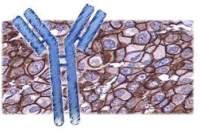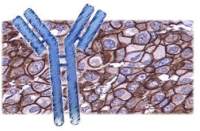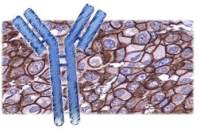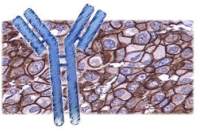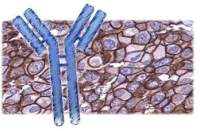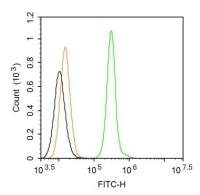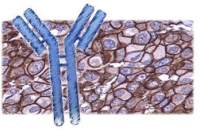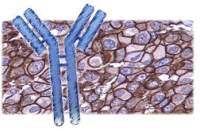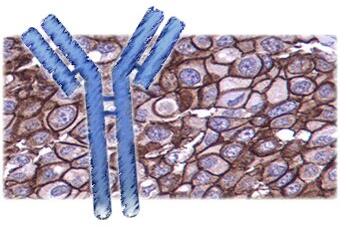
产品详情
文献和实验
相关推荐
供应商 :上海联迈生物工程有限公司
库存 :大量
靶点 :详见说明书
级别 :1
目录编号 :LM-11401R-FITC
克隆性 :多克隆
抗原来源 :Rabbit
保质期 :1年
抗体英文名 :Anti-AKR1C3/FITC
抗体名 :Anti-AKR1C3/FITC
标记物 :FITC标记
宿主 :Human, Dog, Pig, Cow, Horse, Rabbit,
适应物种 :Human, Dog, Pig, Cow, Horse, Rabbit,
免疫原 :详见说明书
亚型 :IGg
形态 :粉末、液体、冻干粉
应用范围 :ICC=1:50-200 IF=1:50-200
浓度 :1mg/ml
保存条件 :-20 °C
规格 :100ul
FITC标记的醛固酮还原酶家族1成员C3抗体| 英文名称 | Anti-AKR1C3/FITC |
| 中文名称 | FITC标记的醛固酮还原酶家族1成员C3抗体 |
| 别 名 | 17 beta HSD 5; 17 beta hydroxysteroid dehydrogenase type 5; 17-beta-HSD 5; 17-beta-hydroxysteroid dehydrogenase type 5; 2-dihydrobenzene-1; 2-diol dehydrogenase; 3 alpha hydroxysteroid dehydrogenase type II; 3-alpha-HSD type 2; 3-alpha-HSD type II; 3-alpha-HSD type II, brain; 3-alpha-hydroxysteroid dehydrogenase type 2; AK1C3_HUMAN; AKR1 C3; AKR1C3; Aldo keto reductase family 1 member C3; Aldo-keto reductase family 1 member C3; brain; Chlordecone reductase; Chlordecone reductase homolog HAKRb; DD-3; DD3; DDH1; DDX; Dihydrodiol dehydrogenase 3; Dihydrodiol dehydrogenase type I; Dihydrodiol dehydrogenase X; HA1753; HAKRB; HAKRe; hluPGFS; HSD17B5; Indanol dehydrogenase; KIAA0119; PGFS; Prostaglandin F synthase; Testosterone 17-beta-dehydrogenase 5; Trans-1; Trans-1,2-dihydrobenzene-1,2-diol dehydrogenase; Type IIb 3 alpha hydroxysteroid dehydrogenase. |
| 规格价格 | 100ul/2980元 购买 大包装/询价 |
| 说 明 书 | 100ul |
| 研究领域 | 肿瘤 细胞生物 神经生物学 信号转导 内分泌病 |
| 抗体来源 | Rabbit |
| 克隆类型 | Polyclonal |
| 交叉反应 | Human, Dog, Pig, Cow, Horse, Rabbit, |
| 产品应用 | ICC=1:50-200 IF=1:50-200 not yet tested in other applications. optimal dilutions/concentrations should be determined by the end user. |
| 分 子 量 | 36kDa |
| 性 状 | Lyophilized or Liquid |
| 浓 度 | 1mg/ml |
| 免 疫 原 | KLH conjugated synthetic peptide derived from human AKR1C3 |
| 亚 型 | IgG |
| 纯化方法 | affinity purified by Protein A |
| 储 存 液 | 0.01M TBS(pH7.4) with 1% BSA, 0.03% Proclin300 and 50% Glycerol. |
| 保存条件 | Store at -20 °C for one year. Avoid repeated freeze/thaw cycles. The lyophilized antibody is stable at room temperature for at least one month and for greater than a year when kept at -20°C. When reconstituted in sterile pH 7.4 0.01M PBS or diluent of antibody the antibody is stable for at least two weeks at 2-4 °C. |
| 产品介绍 | background: DD3 is a unique enzyme that can specifically catalyze the dehydrogenation of trans-benzenedihydrodiol and trans-naphthalenedihydrodiol. Human liver contains isoforms of dihydrodiol dehydrogenase (DD1, DD2, DD3 and DD4), which belong to the aldo-oxo reductase/aldo-keto reductase (AKR) superfamily, have 20Alpha- or 3Alpha-hydroxysteroid dehydrogenase (HSD) activity. DD1 is also designated AKR1C1, DDH or DDH1 while DD2 also can be designated AKR1C2, dDD, BABP or DDH2. AKR1C3 and 3Alpha-HSD are alternate designations for DD3, while DD4 also can be called AKR1C4, CD or CHDR. DD1 and DD2 are 20Alpha-HSDs, whereas DD3 and DD4 are the 3Alpha-HSDs. The multiple human cytosolic dihydrodiol dehydrogenases are involved in the metabolism of xenobiotics, such as polycyclic aromatic hydrocarbons, pesticides and steroid hormones, and are responsible for the reduction of ketone-containing drugs by using NADH or NADPH as a cofactor. The 20Alpha-HSD catalyzes the reaction of progesterone to the inactive form 20Alpha-hydroxyprogesterone. The 3Alpha-HSD is a cytosolic, monomeric, NADPH-dependent oxidoreductase that reduces 3-keto-5-dihydrosteroids to their tetrahydro products. DD1 and DD2 are ubiquitously expressed, whereas DD4 mRNA is restricted to the liver. Function: Catalyzes the conversion of aldehydes and ketones to alcohols. Catalyzes the reduction of prostaglandin (PG) D2, PGH2 and phenanthrenequinone (PQ) and the oxidation of 9-alpha,11-beta-PGF2 to PGD2. Functions as a bi-directional 3-alpha-, 17-beta- and 20-alpha HSD. Can interconvert active androgens, estrogens and progestins with their cognate inactive metabolites. Preferentially transforms androstenedione (4-dione) to testosterone. Subcellular Location: Cytoplasm. Tissue Specificity: Expressed in many tissues including adrenal gland, brain, kidney, liver, lung, mammary gland, placenta, small intestine, colon, spleen, prostate and testis. The dominant HSD in prostate and mammary gland. In the prostate, higher levels in epithelial cells than in stromal cells. In the brain, expressed in medulla, spinal cord, frontotemporal lobes, thalamus, subthalamic nuclei and amygdala. Weaker expression in the hippocampus, substantia nigra and caudate. Similarity: Belongs to the aldo/keto reductase family. Database links: Entrez Gene: 8644 Human Omim: 603966 Human SwissProt: P42330 Human Unigene: 78183 Human Important Note: This product as supplied is intended for research use only, not for use in human, therapeutic or diagnostic applications. |

上海联迈生物工程有限公司
品牌商实名认证
钻石会员
入驻年限:8年

